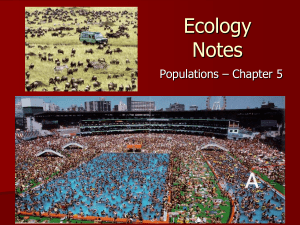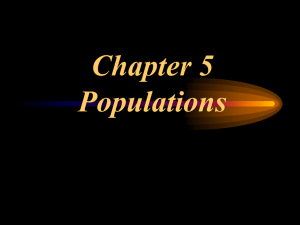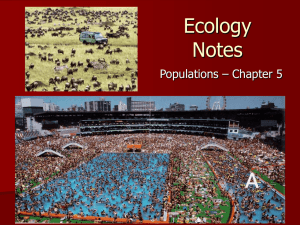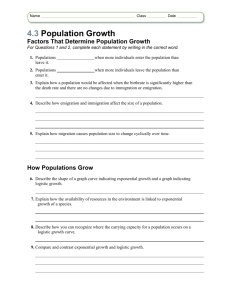File - Mr. Downing Science 20
advertisement
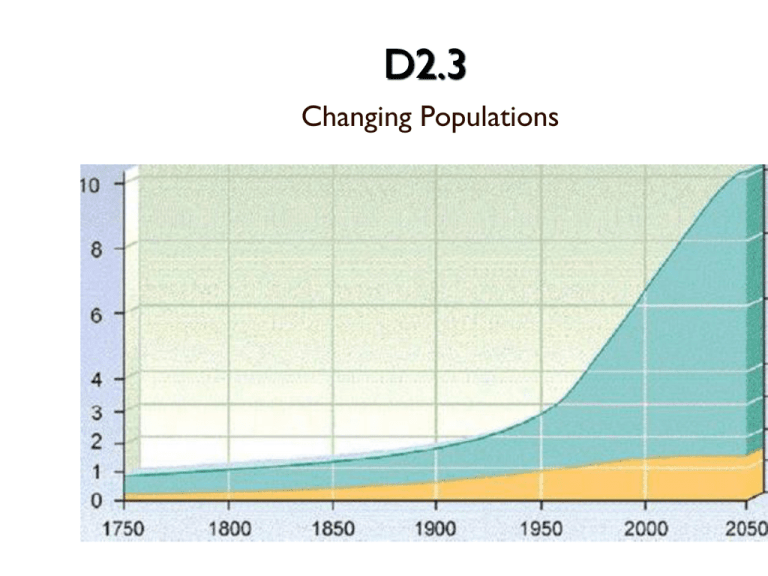
D2.3 Changing Populations Overgrowth in Human Populations • Recall, sustainability is: – the ability for a population (or ecosystem) to be maintained at a certain rate or level, by also ensures the availability of resources in the future. • If a human population grows beyond its capacity, it will experience problems such as: – overcrowding – outbreaks in disease – water, food and housing shortages – pollution and waste accumulation Overgrowth in Human Populations New Delhi, capital of India Ottawa, capital of Canada Pop India: 1,170,938,000 in 3,287,590 km² = 356 ppl/km2 vs. Pop Canada: 34,108,752 in 9,984,670 km² = 3.50 ppl/km2 Growth Rates • The two main growth rate patterns are: – Exponential growth – Logistic Growth • Exponential growth – population growth at an increasingly rapid rate in proportion to the total population size. • Logistic (or constant) growth – population growth that is continuously growing and decreasing over time, as a result of balance within the population. Growth Rates • Bacteria are an example of a population that grows exponentially – Bacteria are single-celled organisms that reproduce by splitting in two. 24 4 8 • the doubling time is the amount of time it takes for a population to double in size – For bacteria that happens in one generation. For populations that DO NOT grow exponentially it takes considerably longer. Growth Rates a population that experiences exponential growth will continue to grow at a faster and faster rate. • for these populations, growth will continue until a limiting factor slows or stops the population’s expansion – in the Ancient Rome example; limiting factors were disease, lack of clean water, food and shelter. – for bacteria; limiting factors would be lack of food, increase in temperature and presence of toxin (antibiotics) Growth Rates a population that experiences exponential growth will continue to grow at a faster and faster rate. Please copy the completed graph into your notes • When exponential growth is graphed, the shape of the line is like the letter “J” – thus, these graphs are also referred to as Jcurves Factors that Support Exponential Growth species that are able to grow exponentially: ◦ have short life spans ◦ reproduce often ◦ produce numerous offspring ◦ do little to care for young Factors that Support Exponential Growth exponential growth can only occur in some organisms, under ideal conditions ◦ most often seen in micro-organisms (e.g. bacteria) small animals (e.g. insects) certain plants (e.g. weeds) Factors that Limit Exponential Growth Scarcity of resources, such as: ◦ ◦ ◦ ◦ food water living space / shelter availability of mates Predation Disease Population Explosions & Crashes • a population explosion is a sudden exponential growth in a population • most ecosystems cannot tolerate exponential population growth for very long… …so the explosions are usually followed a population crash: a rapid drop in population size Please copy the completed graph into your notes This is generally due to the limiting factors in the ecosystem, acting on the population. Factors affecting populations • Most populations experience logistic growth, – by definition, these populations fluctuate in size, in responses to environmental conditions: • Factors that increase population size – births – immigration (movement into the population) Factors affecting populations • Most populations experience logistic growth, – by definition, these populations fluctuate in size, in responses to environmental conditions: • Factors that decrease population size – deaths – emigration (movement out of the population) If all four of these factors can occur in a population, it is called an open population. ◦ If conditions prevent immigration and emigration, the population is said to be closed Carrying Capacity Equilibrium the carrying capacity will of a alternate population • While some populations is the maximum number of individuals between explosions and crashes, most will thatancan be sustained in an ecosystem find equilibrium Carrying Capacity • the curve for a population that is being limited by its carrying capacity is called an S-curve Human Population Growth • for most of its history, the human population has been stable or grown very slowly • explosive growth of the human population is linked with advancements in agriculture, industry, science/medicine specifically the Industrial Revolution of the 18th century living conditions improve (better hygiene linked with higher education) death rate lowered due to advancements in medicine Human Population Growth • the 21st century is the first time in the world’s history that the elderly will out number the youth • the carrying capacity of the Earth depends on: food and resource supply waste disposal pollution access to clean water distribution of populations Human Population Growth The current population of the world is about •◦ Recall the term “sustainability” 7,237,851,917 (~7 billion) The human population is NOT currently growing in a –growing at an annual rate of 1.7%, will add approximately 93 million sustainable people / year way. ◦ The carrying capacity of the Earth is estimated to be around ~12 billion If the human population growth continues at its current rate of growth, scientists estimate it will reach the earth’s carrying capacity in ~ 53 years Human Population Growth • Recall the term “sustainability” – Will the the human population be an S-curve… …or a J-curve? • PRACTICE PROBLEMS # 7, 8, 10 & 11 (pg 484) 18-22 (pg 485) • 2.3 Summary Q. 5 (pg 487)


